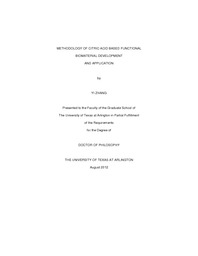
ATTENTION: The works hosted here are being migrated to a new repository that will consolidate resources, improve discoverability, and better show UTA's research impact on the global community. We will update authors as the migration progresses. Please see MavMatrix for more information.
Show simple item record
| dc.contributor.author | Zhang, Yi Leaf | en_US |
| dc.date.accessioned | 2013-03-20T19:10:50Z | |
| dc.date.available | 2013-03-20T19:10:50Z | |
| dc.date.issued | 2013-03-20 | |
| dc.date.submitted | January 2012 | en_US |
| dc.identifier.other | DISS-11849 | en_US |
| dc.identifier.uri | http://hdl.handle.net/10106/11517 | |
| dc.description.abstract | Biomaterials play critical roles in modern strategies of biomedical applications, such as tissue engineering, and theranostic therapy. Attempts to design ideal biomaterials for each specific application have led to an enormous increase in the number of polymeric biomaterials. Different biomedical applications require specific functionality of biomaterials. Unfortunately, the limited versatility of currently available biodegradable polymers fails to meet the wide range of requirement for biomedical applications. Therefore, a methodology of functional biomaterials development would be beneficial to the biomaterial field. It has been proved that citric acid can be utilized as a key element in the development of novel biodegradable polymers. This work presents the methodology of three citric acid based functional biomaterials design and application to meet the multifaceted needs of tissue engineering and theranostic therapy. Firstly, urethane doped biodegradable polyester with dual crosslinking mechanism is developed as scaffold materials to fulfill the wide range of mechanical properties of soft tissue engineering. We hypothesize that doping of urethane bond can greatly increase the mechanical strength and elasticity, and dual crosslinking mechanism confers parameters to manipulate mechanical properties over a wide range. Secondly, novel family of biodegradable photoluminescent polymers (BPLPs) is developed meet the increasing needs of marriage between biodegradable polymers and bioimaging. We hypothesize that the intrinsic strong fluorescence of BPLPs can be exploited as theranostic probes, and provide possibility of real-time monitoring for implants. Lastly, BPLPs are doped with urethane bond (UBPLPs) to achieve an ultra strong elastomer with strong fluorescence. We hypothesize that the greatly increased mechanical strength makes UBPLPs suitable for engineering cardiovascular tissue. It also can improve the stability of nanoparticles for theranostic application. To test these hypotheses, we first developed the methodology of all three functional biodegradable polymers. The synthesis, characterization, fabrication, and application of those polymers were discussed. The relationship between materials chemistry and phenomenon were devoted to the understanding of basic biomaterials science. The results presented in this work show that all three functional polymers succeed to fulfill the requirements of specific biomedical applications. The designing strategies can serve as a guide for developing of new citric acid based biodegradable polymers. These enabling new biodegradable polymers are able to address many of the existing challenges in tissue engineering, and theranostic applications. | en_US |
| dc.description.sponsorship | Yang, Jian | en_US |
| dc.language.iso | en | en_US |
| dc.publisher | Biomedical Engineering | en_US |
| dc.title | Methodology Of Citric Acid Based Functional Biomaterial Development And Application | en_US |
| dc.type | Ph.D. | en_US |
| dc.contributor.committeeChair | Yang, Jian | en_US |
| dc.degree.department | Biomedical Engineering | en_US |
| dc.degree.discipline | Biomedical Engineering | en_US |
| dc.degree.grantor | University of Texas at Arlington | en_US |
| dc.degree.level | doctoral | en_US |
| dc.degree.name | Ph.D. | en_US |
Files in this item
- Name:
- Zhang_uta_2502D_11849.pdf
- Size:
- 3.261Mb
- Format:
- PDF
This item appears in the following Collection(s)
Show simple item record


